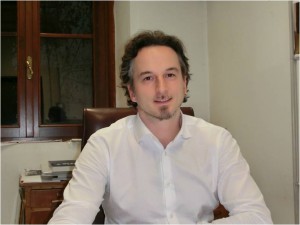G ianfranco Pasut is Assistant Professor of “Delivery and Formulation of Biotech Drug” at the Department of Pharmaceutical and Pharmacological Sciences, University of Padova (Italy), since 2006. He received a M.S. in Pharmaceutical Chemistry and Technology in 1999 and his PhD degree in Pharmaceutical Sciences from University of Padova in 2003 with Prof. Francesco Veronese. In the 2001, he joined for one year the lab of Prof. Irwin Chaiken at the University of Pennsylvania (USA) and in 2007 he was “Visiting Scientist” at the School of Pharmacy, University of Reading (UK). His current research interests are focused on using polymers for the delivery of protein and small drugs. Studies have taken into consideration either synthetic or natural polymers such as poly(ethylene glycol) (PEG), poly (2-Ethyl 2-Oxazoline), hyaluronic acid, polyglutamic acid and polysialyc acid. Pasut has developed several protein conjugates and he has also studied new approaches of protein-polymer conjugation by exploiting the enzyme transglutaminase. In the field of drug delivery of small drugs, he investigated new targeted conjugates and conjugates for combination therapy. He has published 45 articles, 11 book chapters and is the inventor of 9 patents.
ianfranco Pasut is Assistant Professor of “Delivery and Formulation of Biotech Drug” at the Department of Pharmaceutical and Pharmacological Sciences, University of Padova (Italy), since 2006. He received a M.S. in Pharmaceutical Chemistry and Technology in 1999 and his PhD degree in Pharmaceutical Sciences from University of Padova in 2003 with Prof. Francesco Veronese. In the 2001, he joined for one year the lab of Prof. Irwin Chaiken at the University of Pennsylvania (USA) and in 2007 he was “Visiting Scientist” at the School of Pharmacy, University of Reading (UK). His current research interests are focused on using polymers for the delivery of protein and small drugs. Studies have taken into consideration either synthetic or natural polymers such as poly(ethylene glycol) (PEG), poly (2-Ethyl 2-Oxazoline), hyaluronic acid, polyglutamic acid and polysialyc acid. Pasut has developed several protein conjugates and he has also studied new approaches of protein-polymer conjugation by exploiting the enzyme transglutaminase. In the field of drug delivery of small drugs, he investigated new targeted conjugates and conjugates for combination therapy. He has published 45 articles, 11 book chapters and is the inventor of 9 patents.
Website: http://pasutlab.altervista.org/Home.html Contact: gianfranco.pasut@unipd.it
What was your inspiration in becoming a chemist?
Chemistry was not my first choice, I simple didn’t know enough about it. When I was at the high School, I was interested in mechanics but a great teacher perfectly introduced me into the fascinating world of chemistry. Those days changed my life because later I decided to study pharmaceutical chemistry at the University, seeking for a possibility to join the potentials of chemistry with the prospect to help people. Later on, during my PhD, Prof. F.M. Veronese guided me into the field of drug delivery where I started my studies with polymers.
What was the motivation to write your Polymer Chemistry article?
The motivation that fuelled the research study reported in the paper arrived after a discussion with a colleague, who is also a friend (Prof F. Greco, University of Reading, co-authoring the paper). We were discussing about polymer conjugates in drug delivery and the advantages and pitfalls of several approaches. We ended the talk with two considerations, first, polysialic acid has not been studied as drug carrier of an actual small drug and, second, there were not studies comparing systematically the role of the polymer in drug-polymer conjugates. We decided to undertake both investigations at once!
Why did you choose Polymer Chemistry to publish your work? (DOI:10.1039/C2PY20876H)
Although Polymer Chemistry is a new journal it is already recognized as one of the leading journal in its field and we thought that our paper would fit within the scope of the journal and it would be read by a large audience. Another important point is that we appreciated a lot the papers published in this journal and their quality.
In which upcoming conferences may our readers meet you?
I’ll present at Biotech Conference & Expo 2013, May 12-16, Washington (DC) (http://www.techconnectworld.com/Biotech2013/bio.html) and I am planning to attend the Controlled Release Society Annual Meeting in July.
How do you spend your spare times?
I like to spend my spare time with my wife and our two sons, 2.5 years and 1 month! So you can imagine that now I do not have much free time. We have fun also with our dog, a dachshund called PEG (a proper name for a kind of “long chain” dog!)
Which profession would you choose if you were not a scientist?
As mentioned above my first passion was mechanics and still like a lot this matter and especially almost everything that has an engine, so likely I would have been working in this field.
Cyrille Boyer is a guest web-writer for Polymer Chemistry. He is currently a Senior Lecturer and an ARC-Future Fellow at the Australian Centre for NanoMedicine (School of Chemical Engineering, University of New South Wales (Australia)).










